
The Figure 1 photograph is of my model of a Druine Turbulent aircraft.
The Turbulent aircraft was designed for home construction by French genius Roger Druine and a significant number were produced for sale by light aircraft manufacturers.
Around 2003 a friend built a free flight model Turbulent from an Aeromodeller plan drawn by doyen of the British modelling press, the late Ron Moulton.
Powered by a DC Dart Diesel engine my friend and I spent a considerable time unsuccessfully trying to trim the model for consistent flight; despite a claim in the plans catalogue that it was easy to fly!
I had an opportunity to mention our problem to Ron at the funeral of Dave Hughes, another doyen of the aeromodelling press. “A good subject for micro radio control!” was Ron’s comment
Ron also related how Roger piloted the prototype Turbulent to model aircraft meetings in the UK.
[Roger Druine was an aero modeller who progressed into the design of ‘full size’ aircraft; designing and flying his first aircraft in 1936 when he was 16 years of age. His early death at the age of 37 in 1958 robbed the world of a talented man].
The outcome of this discussion was my decision to build the model depicted in Figure 1, which has sat un-flown in my workshop for many years with dust accumulating in the wing slots.
The reader might ask “Why hasn’t it been flown?” The answer to this question relates to the system of radio control which was used originally for this and similar models:-
The models depicted in Figure 2 were originally built with 35 Mhz 'nano' size receivers. These receivers were probably intended for indoor flying because I found that their range was very limited; with servos going potty (no failsafe) at quite modest ranges. Recently the models have been modified to take 2.4GHz receivers and they are ready to fly again. |
The high wing monoplane in Figure 2 might be unfamiliar to some aircraft enthusiasts. It is of a model of a Compte AC4 Gentleman which is the oldest Swiss built aircraft flying.
It also was constructed from an Aeromodeller free flight plan and it was converted for radio control after flying free with a DC Merlin up front. A brief interim experiment with rudder only radio assist using 27Mhz gear was not successful because of the restricted capacity of the inbult fuel tank; leading to the installation of a brushless motor and three channel radio.
Apparently the AC4 was operated on scheduled services by Swissair in the early 1930s. It was capable of carrying one or possibly two passengers so I doubt that in-flight meals were served. About six aircraft were built using in-line Cirrus-Hermes engines but the one which has been restored to flying condition was later fitted with an Armstrong Siddeley Genet radial. A recent photograph of the restored aircraft shows that the tailskid has been replaced with a wheel to permit operation from hard runways and that the shape of the fin/rudder has been has been modified accordingly. This rather spoils the effect by making the aircraft more modern looking than it is.
The Tiger Moth is built from an original Mercury free flight kit converted for electric powered radio control. I suppose a kit of more than 60 years old is a collectable but it was given to me to build so I built it.
The Pixie is one of my favourite designs, because the original 23" span rubber powered version was the first scale-looking model I got to fly well as a lad. As a result I have three in my stable: one rubber powered to the standard plan, one twice scale also for rubber power and one 2.5 scale for electric powered and radio control. These are shown in Figure 4.
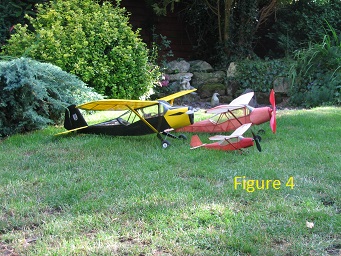
Spans of these models range from 23" to 57.5" and all are excellent flyers. The extensive cabin glazing heightens the impression of full size practice, giving the model pilot an excellent all round view.

The model shown in Figure 5 is a West Wings Toucan. Is certainly not scale or semi-scale but it is influenced by the Shorts Tucano used for pilot training by the RAF.
The model is designed for electric r.c. flight with a 300 size motor without an undercarriage.
I prefer my models to take off from the gound and consequently it was built with an undercarriage and the optional 400 size brushed motor.
As such it flew smoothly except for an apparent tendency to stall on the landing approach. Consequently I designed a wing of 25% greater area as shown.
With this wing it flew equally well but it was reluctant to get off the ground with the limited power available.
As most of my small models utilised these receivers, I progressively changed them to 2.4 GHz operation.
GHz gear, the opportunity was taken to fit a 480 size brushless motor and ESC. and, with an appropriate prop, the extra power greatly shortened the take off run.
In this configuration the model was relaxing to fly and the temptation to fly it with the original wing couldn't be avoided.
Of course it flew (and now flies) perfectly with the original wing; indicating that 'improving' an established design is not always a good idea.
The Toucan with its original wing is shown in Figure 6
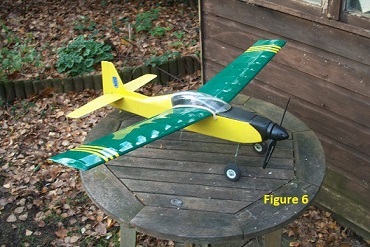

The model depicted in Figure 8 is a conversion from a free flight design by that most prolific of designers the late Vic Smeed. The Majorette plan was published in the Aeromodeller magazine in the 1990s and I thought that it might be a good subject on which to experiment with electric power and radio control. Someone else had the same idea because I encountered a beautifully constructed example, covered with translucent plastic film, at an RAF Halton model show, before mine was complete and recently another example has been featured on page 32 of the Norcim website and which must have been constructed about the same time.
Originally the Majorette was covered with blue and yellow nylon but latterly it has been given a face lift and recovered with black and yellow plastic film.
Despite the accumulation of many flying hours over the last 25 years or so, the original brushed motor and Simprop gearbox are still installed but the full gamut of suitable rechargeable battery technologies
have been tried with varing success over the period.
Radio controlled versions of free flight designs are easy to fly because of their inherent stabilty but they are not easy to fly well. The dihedral necessary for stability in free flight designs ( in this case polyhedral) results in a marked tendency to Dutch roll, or even to spiral down, in turns; so a light touch on the stick is essential for smooth flight.
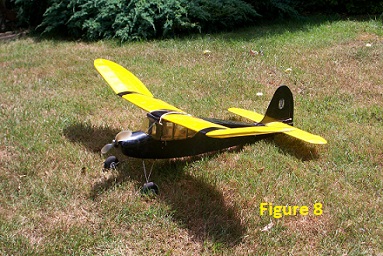
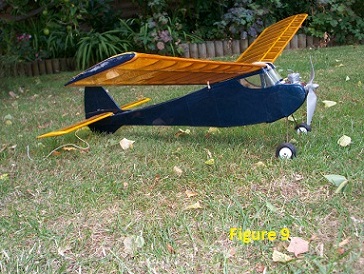
Another of Vic's free flight designs,and arguably the most famous, is the Tomboy shown in Figure 9.
As a free flight model anybody can get the Tomboy to fly well and it copes extremely well in windy weather.
Converted to radio it is a bit twitchy in turns but it is completely foregiving if left to its own devices.
Sharp eyed readers will observe that this example is on the 35MHz band and that the ED Bee Diesel engine is in fact a dummy; the model being electric powered.
The electric power train for the Tomboy, shown in Figure 10, utilises a 400 size brushed motor with a homemade reduction gear. Also shown is the heavy eight cell NiCad battery used originally.
Performance and flight duration with this battery was very limited and its subsequent replacement by a battery having two or three 800mA-h Lipo cells resulted in lively performance with a flight duration of 10 minutes or more.
It is hard to believe that the little ESC. is good for 20 Amps but that is what it says on the label.
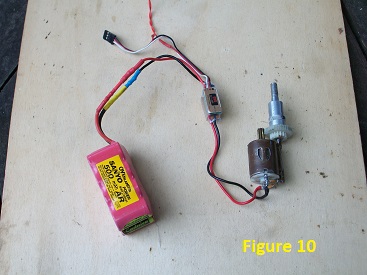
Small scale or semi scale models might be a little more tricky to fly than larger models but, to my mind, the convenience of being able to put them in the car fully rigged outweighs any disadvantage.
Sadly the building of model aircraft seems to be in decline with many people preferring to buy 'ready to fly' models. There is no doubt that these are usually excellent flying machines but, for the author, the
joy is that of creating a flyable model aircraft, whether radio controlled or free flight. Seeing it fly is the 'icing on the cake'.
Sadly the club of which I used to be a member has lost its flying field and folded and consequently the models on this page might never fly again.
Talking of models which might not fly again, my first love is of free flight models; for which the availability
of flying sites in Southern England has become very limited.Consequently my free flight models have languished unflown for a number of years.
The models which i like to fly are ones which I made and flew in my youth ( when England was far less crowded) and an example of which is the Keil Kraft Southerner Mite depicted in Figure 11. This is powered by a Czech MP Jet Diesel of 0.6cc capacity.
I also have its sister Slicker Mite, which is identical except that it has a pylon fuselage as opposed to a cabin fuselage.

Not really surprising when one considers plans for a third runway at Heathrow at a time when the future of air travel in general needs to be reviewed with regard to its impact on the climate.
All is not lost because the local chalk downs haven't been built upon (yet) and I am able still to go slope soaring. Not wishing to 'toe the line' and to register with the CAA, I have decided to fly models weighing less than 250gm which are exempt from registration.
The model shown in Figure12 is an own design soarer with this object in view. It is a two channel radio controlled soarer of 1m span and it weighs-in at just less than 200gm in flying trim.
Details of the model are to be found on page 33
of the Norcim site.
All information is free to use.